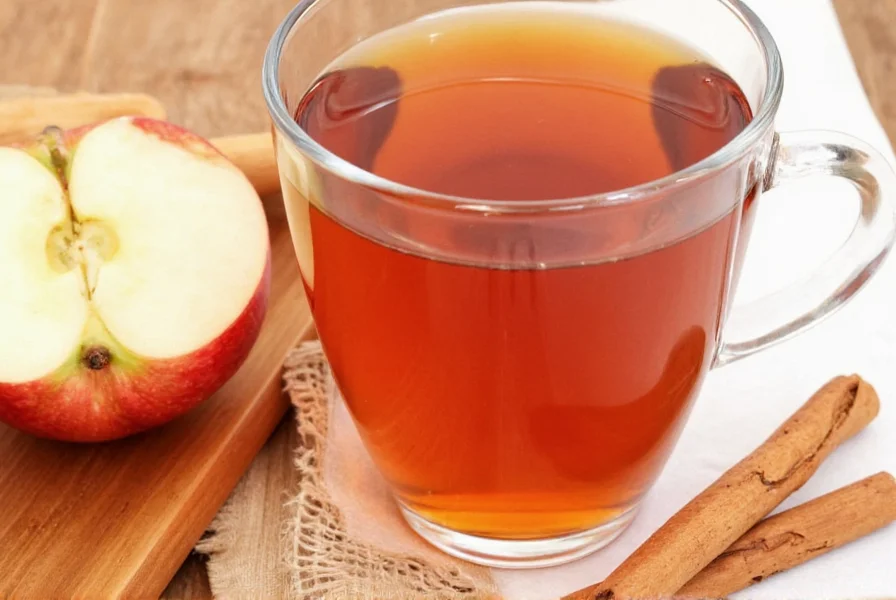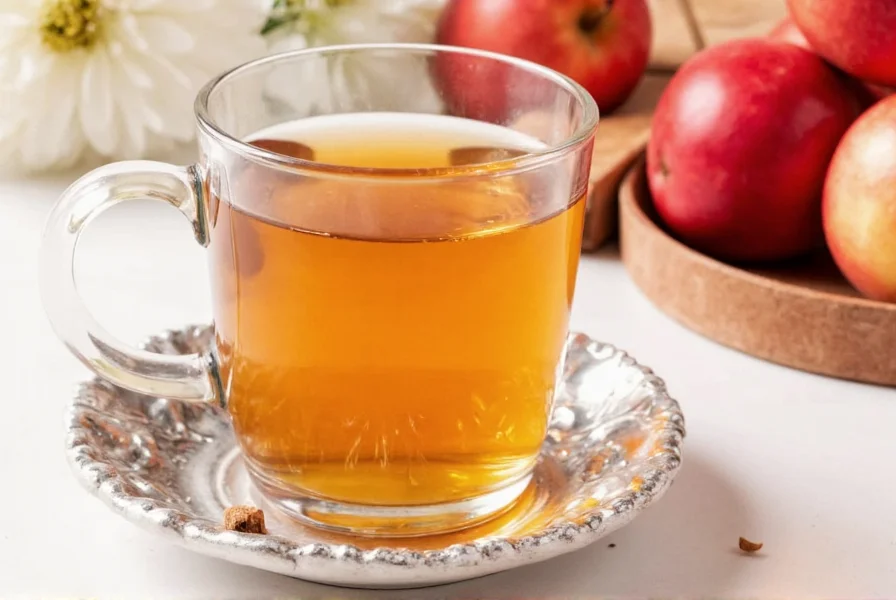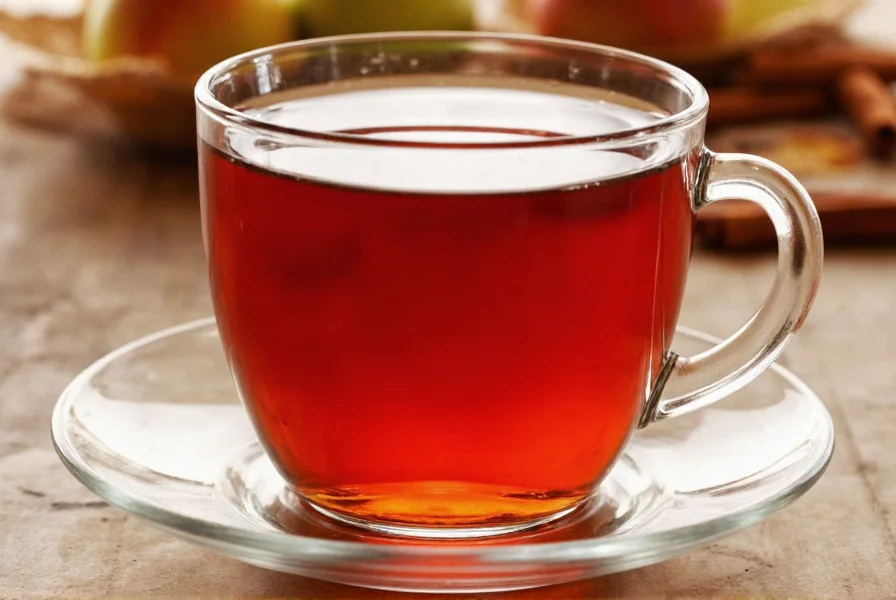When exploring how to make apple cinnamon tea at home, you'll discover a straightforward process that transforms basic ingredients into a comforting beverage. Unlike commercial tea blends that often contain added sugars or artificial flavors, homemade versions let you control every element while preserving the natural synergy between these two ingredients.
What Exactly Is Apple and Cinnamon Tea?
This popular herbal infusion combines the natural sweetness of apples with the warm spice of cinnamon. Despite its name, it's not technically a "tea" since it contains no leaves from the Camellia sinensis plant. Instead, it's classified as a tisane or herbal infusion. The most authentic versions use fresh apple slices or peels along with whole cinnamon sticks, allowing the natural compounds to slowly release during simmering.
| Ingredient | Common Forms Used | Preparation Tip |
|---|---|---|
| Apple | Fresh slices, dried pieces, juice, or peel | Use organic apples with peel for maximum nutrient retention |
| Cinnamon | Whole sticks, ground powder, or quills | Ceylon cinnamon contains lower coumarin levels than Cassia |
| Liquid Base | Water, apple juice, or herbal tea | Combining water with 25% apple juice enhances natural sweetness |
Creating the Perfect Apple Cinnamon Tea Recipe
Follow this simple method for an apple cinnamon tea recipe without sugar that highlights natural flavors:
- Wash and thinly slice one organic apple (leaving peel on)
- Add 2 cups of water and 1-2 cinnamon sticks to a small pot
- Bring to a gentle simmer (not boiling) for 5 minutes
- Add apple slices and continue simmering for 10-15 minutes
- Remove from heat, cover, and steep for 5 additional minutes
- Strain and serve warm, optionally adding lemon or fresh ginger
This preparation method maximizes the extraction of beneficial compounds while creating a balanced flavor profile. For a cold apple cinnamon tea variation, refrigerate the strained liquid and serve over ice with a cinnamon stick garnish.

Understanding the Flavor Profile and Best Consumption Times
Apple cinnamon tea offers a naturally sweet, warming flavor with subtle tart notes from the apple and spicy warmth from the cinnamon. The taste evolves as it steeps, becoming more complex and balanced. This beverage works well as:
- An evening drink to support relaxation before bedtime
- A morning alternative to coffee for those reducing caffeine
- A post-meal digestive aid when consumed warm
- A comforting beverage during cold seasons
Unlike many commercial apple cinnamon tea blends that contain added sugars or artificial flavors, homemade versions provide pure flavor without unnecessary additives. The natural sweetness typically eliminates the need for additional sweeteners, making it suitable for various dietary preferences.
Potential Health Benefits Supported by Research
While not a medical treatment, apple and cinnamon tea contains compounds studied for their potential wellness properties. Apples provide polyphenols like quercetin and chlorogenic acid, while cinnamon contributes cinnamaldehyde and other bioactive compounds. Research suggests these components may support:
- Natural antioxidant activity that helps combat oxidative stress
- Metabolic support when consumed as part of a balanced diet
- Digestive comfort due to the warming properties of cinnamon
- Immune system support through various phytonutrients
A 2022 review in the Journal of Functional Foods noted that the combination of apple polyphenols and cinnamon compounds shows synergistic effects in laboratory studies. However, these findings don't translate to specific health claims for tea consumption in humans.

Nutritional Content Analysis
A standard 8-ounce serving of homemade apple cinnamon tea (without added sweeteners) typically contains:
- Calories: 5-15 (depending on apple variety)
- Natural sugars: 1-3g
- Dietary fiber: trace amounts
- Vitamin C: 2-5% of daily value
- Polyphenols: significant amounts from both ingredients
Compared to commercial apple cinnamon tea bags, homemade versions generally contain higher concentrations of beneficial compounds since they're made from whole ingredients rather than processed tea blends.
Storage and Shelf Life Guidelines
For optimal freshness and flavor retention:
- Refrigerate cooled tea in airtight containers for up to 3 days
- Avoid storing with metal utensils which can affect flavor
- Freeze in ice cube trays for longer preservation (up to 2 months)
- Reheat gently without boiling to preserve delicate compounds
Unlike many pre-packaged apple cinnamon tea products, homemade versions don't contain preservatives, so proper storage is essential for maintaining quality.
Frequently Asked Questions
Can I drink apple cinnamon tea every day?
Yes, moderate daily consumption of homemade apple cinnamon tea is generally safe for most people. When using Cassia cinnamon (the more common variety), limit to 1-2 cups daily due to its higher coumarin content. Ceylon cinnamon allows for slightly higher consumption. Those with specific health conditions should consult their healthcare provider.
What's the best time to drink apple cinnamon tea for digestion?
For digestive support, consume apple cinnamon tea 15-20 minutes after meals while it's still warm. The combination of apple pectin and cinnamon's natural properties may help support comfortable digestion. Avoid drinking it too hot, as extremely hot beverages can sometimes irritate the digestive tract.
How does homemade apple cinnamon tea differ from store-bought versions?
Homemade versions typically contain whole food ingredients without additives, while commercial blends often include tea leaves, added sugars, artificial flavors, or preservatives. Homemade tea allows control over ingredient quality and preparation method, resulting in higher concentrations of natural compounds. Commercial tea bags offer convenience but generally contain lower-quality ingredients and less potent flavor profiles.
Can I make apple cinnamon tea without actual tea leaves?
Absolutely. Traditional apple cinnamon tea is naturally caffeine-free and doesn't require any tea leaves. The authentic version combines only apple components and cinnamon with water. Many commercial products misleadingly include black or green tea, but a pure apple cinnamon infusion stands beautifully on its own ingredients without any tea leaves.
Does apple cinnamon tea help with weight management?
While no beverage alone affects weight, apple cinnamon tea can be a valuable component of a balanced approach. Its natural sweetness may reduce cravings for sugary drinks, and its low calorie content makes it suitable for hydration between meals. Some studies suggest cinnamon may support healthy metabolic function, but tea consumption should be viewed as part of an overall healthy lifestyle rather than a weight management solution.











 浙公网安备
33010002000092号
浙公网安备
33010002000092号 浙B2-20120091-4
浙B2-20120091-4